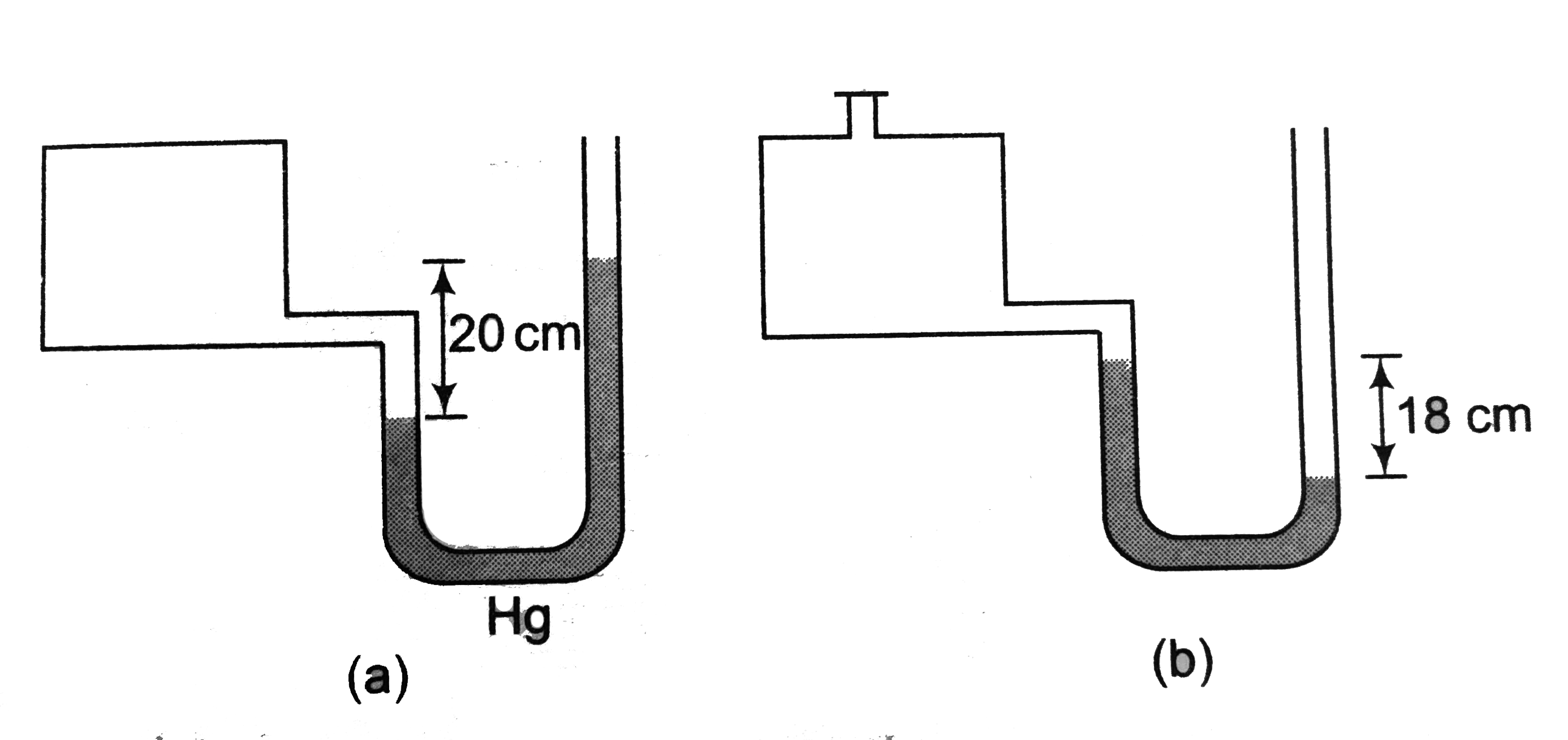A manometer is connected to a gas containing bulb The open arm reads 43.7cm where as the arm connected to the bulb reads 15.6cm If the barometric pressure is 743mm mercury What is the pressure of gas in bar ? .
To find the pressure of the gas in bar using the manometer readings and the barometric pressure, we can follow these steps:
Step 1: Calculate the difference in mercury levels.
The difference in height between the two arms of the manometer is given by:
Difference=Height of open arm−Height of gas arm
Substituting the given values:
Difference=43.7cm−15.6cm=28.1cm
Step 2: Convert barometric pressure to centimeters of mercury.
The barometric pressure is given as 743 mm Hg. We can convert this to centimeters:
Barometric Pressure=743mm10=74.3cm
Step 3: Calculate the pressure of the gas in centimeters of mercury.
The pressure of the gas can be calculated by adding the barometric pressure to the height difference:
Pressure of gas=Barometric Pressure+Difference
Substituting the values:
Pressure of gas=74.3cm+28.1cm=102.4cm
Step 4: Convert the pressure from centimeters of mercury to atmospheres.
We know that 76 cm of Hg is equivalent to 1 atm. Therefore, we can convert the pressure of the gas to atm:
Pressure in atm=102.4cm76cm≈1.347atm
Step 5: Convert the pressure from atmospheres to bars.
Using the conversion factor where 1 atm = 1.013 bar, we can convert the pressure in atm to bar:
Pressure in bar=Pressure in atm×1.013
Substituting the value:
Pressure in bar=1.347atm×1.013≈1.365bar
Final Answer:
The pressure of the gas is approximately 1.365 bar.
---
The difference in height between the two arms of the manometer is given by:
The barometric pressure is given as 743 mm Hg. We can convert this to centimeters:
The pressure of the gas can be calculated by adding the barometric pressure to the height difference:
We know that 76 cm of Hg is equivalent to 1 atm. Therefore, we can convert the pressure of the gas to atm:
Using the conversion factor where 1 atm = 1.013 bar, we can convert the pressure in atm to bar:
The pressure of the gas is approximately 1.365 bar.
Similar Questions
A manometer is connected to a gas containing bulb. The open arm reads 40.0cm where as the arm connected to the bulb reads 15.0cm. If barometric pressure is 74.0cmHg, then what is the pressure of gas in bar?
View SolutionA gas is filled into a bulb connected to an open limb manometer. The level of mercury in the open arm is 2.1 cm lower than that in the other arm of the manometer. The atmospheric pressure is 740 mm. What is the pressure of the gas?
View Solution
Knowledge Check
A manometer reads the pressure of a gas in an enclosure as shown in the figure. The absolute and gauge pressure of the gas in cm of mercury is (take atmospheric pressure =76 cm of mercury)
A76,20B20,76C96,20D20,96
The manometer has a water column difference of 50 cm . If the atmospheric pressure is 105 Pa, find the pressure of the gas in the container .
View SolutionThe difference in the heights of mercury levels in an open end manometer connected to a gas chamber is found to be 175 mm. If the height of mercury level in the smaller limb is more as compared to that in the longer limb and the atmospheric pressure is 755 mm, what is the pressure of the gas ?
View SolutionA faulty barometer contains certains amount of air and saturated water vapour . It reads 74.0cm when the atmospheric pressure is 76.0cm of mercury and reads 72.10cm when the atmospheric pressure is 74.0cm of mercury.Saturation vapour pressure at air temperature =1.0cm of mercury. Find the length of the baromerer tube above the mercury level in the reservoir.
View SolutionA manometer reads the pressure of a gas in a enclosure as shown in figure(a) When some of the gas is removed by a pump, the manometer reads as in (b). The liquid used in the manometers is mercury and the atmospheric pressure is 76cm of mercury.

(i) Give the absolute and gauge pressure of the gas in the enclosure for cases (a) and (b) in units of cm of mercury .
(ii) How would the level change in case (b) if 13.6cm of water are poured into the right limb of the manometer?
View SolutionA manometer reads the pressure of a gas in a enclosure as shown in figure(a) When some of the gas is removed by a pump, the manometer reads as in (b). The liquid used in the manometers is mercury and the atmospheric pressure is 76cm of mercury.

(i) Give the absolute and gauge pressure of the gas in the enclosure for cases (a) and (b) in units of cm of mercury .
(ii) How would the level change in case (b) if 13.6cm of water are poured into the right limb of the manometer?
View SolutionThe difference in the heights of mercury columns in a closed end manometer connected to a gas container is found to be 15 cm. What is the pressure of the gas in terms of Pa ?
View SolutionTwo discharge tubes have identical material structure and the same gas is filled in them. The length of one tube is 10cm and that of th other tube is 20cm. Sparking starts in both the tubes when the potential difference between the cathode and the anode is 100V. If the pressure in the shorter tube is 1.0mm of mercury, what is the pressure in the longer tube?
View Solution
